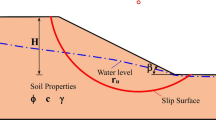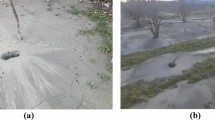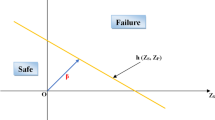Abstract
This paper proposes an AI-based prediction method for factor of safety (FOS) against rupture and pull-out failure and examines and compares the applicability and adaptability of k-nearest neighbor (KNN), random forest (RF), and extreme gradient boosting (XGBoost) in the reliability analysis of internal stability of mechanically stabilized earth wall. In order to predict FOS against rupture and pull-out failure, these three machine learning (ML) models are applied to 100 datasets, taking into account three crucial input parameters, namely, the depth of the reinforcement layer below the wall’s crest, the angle of internal friction of soil, and the unit weight of soil. A variety of performance indicators, including coefficient of determination (R2), variance account factor, Legate and McCabe’s index, A-10 index, root mean square error (RMSE), expanded uncertainty, mean absolute error, and median absolute, are engaged to assess the effectiveness of the well-established ML models. The results, which are based on performance metrics, indicate that XGBoost outperformed in both the two cases, i.e., rupture and pull-out, than the other proposed machine learning models in terms of predictive performance. This can be attributed to its highest R2 = 0.999 and lowest RMSE = 0.002 (in case of rupture) and highest R2 = 0.999 and lowest RMSE = 0.003 (in case of pull-out failure) during the training phase, as well as its highest value of R2 = 0.864 and lowest value of RMSE = 0.102 (in case of rupture) and R2 = 0.944 and RMSE = 0.054 (in case of pull-out failure) during the testing phase. Rank analysis, reliability analysis, regression plot, confusion matrix, and error matrix plot are the other tools used to assess the performance of the model. Using first-order second moment methods, the reliability index of the model is computed and compared to the actual value for both cases. Sensitivity analysis is also performed to regulate the effect of each input parameter on both outputs.















Similar content being viewed by others
Data Availability
Data presented in the paper are available with authors.
References
AASHTO: Standard practice for determination of long-term strength for geosynthetic reinforcement. American Association of State Highway and Transportation Officials, Washington, DC USA (2015)
AASHTO: LRFD bridge design specifications 8th ed. American Association of State Highway and Transportation Officials, Washington DC, USA (2017)
Abu-Farsakh, M.Y., Shoaib, M.M.: Machine learning models to evaluate the load-settlement behavior of piles from cone penetration test data. Geotech. Geol. Eng. (2024). https://doi.org/10.1007/s10706-023-02737-6
Ahmad, F., Samui, P., Mishra, S.S.: Probabilistic slope stability analysis on a heavy-duty freight corridor using a soft computing technique. Transp. Infrastruct. Geotech. (2023). https://doi.org/10.1007/s40515-023-00365-4
Ahmad, F., Samui, P., Mishra, S.S.: Probabilistic slope stability analysis using subset simulation enhanced by ensemble machine learning techniques. Model. Earth Syst. Environ. 10, 2133–2158 (2024a). https://doi.org/10.1007/s40808-023-01882-4
Ahmad, F., Samui, P., Mishra, S.S.: Machine learning-enhanced Monte Carlo and subset simulations for advanced risk assessment in transportation infrastructure. J. Mt. Sci. 21, 690–717 (2024b). https://doi.org/10.1007/s11629-023-8388-8
Ahmadi, H.: Geosynthetic reinforced soil retaining walls subjected to surcharge loads. PHD Dissertation Ghent University, Ghent, Belgium (2020)
Basheer, I.A., Najjar, Y.M.: Reliability based design of reinforced earth retaining walls. Transp. Res. Rec. 1526(1), 64–78 (1996). https://doi.org/10.1177/0361198196152600109
Bathurst, R.J.: The basics of probabilistic internal stability analysis and design of reinforced soil walls explained. In: Proceedings of the 11th International Conference on Geosynthetics, Seoul, Korea (2018)
Bathurst, R.J., Allen, T.M., Miyata, Y., Javankhoshdel, S., Bozorgzadeh, N.: Performance based analysis and design for internal stability of MSE walls. Georisk: Assess. Manag. Risk. Eng. Syst. Geohazards. (2019a) https://doi.org/10.1080/17499518.2019.1602879
Bathurst, R.J., Lin, P., Allen, T.M.: Reliability based design of internal limit states for mechanically stabilized earth walls using geosynthetic reinforcement. Can. Geotech. J. 56(6), 774–788 (2019b). https://doi.org/10.1139/cgj-2018-0074
Berg, R.R., Christopher, B.R., Samtani, N.C.: Design and construction of mechanically stabilized earth walls and reinforced soil slopes. FHWA NHI-10–024 Volume I and NHI-10–025 Volume II,US. Department of Transportation, Federal Highway Administration, Washington, DC, 306p (vol I) and 380p (vol II) (2009)
Bozorgzadeh, N., Bathurst, R.J., Allen, T.M., Miyata, Y.: Reliability based analysis of internal limit states for MSE walls using steel strip reinforcement. J. Geotech. Geoenviron. Eng. 146(1), 04019119 (2020). https://doi.org/10.1061/(ASCE)GT.1943-5606.0002192
Breiman, L.: Random forests. Mach. Learn. 45(1), 5–32 (2004)
Chalermyanont, T., Benson, C.H.: (2004) Reliability based design for internal stability of mechanically stabilized earth walls. J. Geotech. Geoenviron. Eng. 130(2), 163–173 (2004). https://doi.org/10.1061/(ASCE)1090-0241(2004)130:2(163)
Chen, T., Guestrin, C.: XGBoost: a scalable tree boosting system. KDD 16: Proc. 22nd ACM SIGKDD Int. Conf. Knowl. Discov. Data Mining 785–794 (2016) https://doi.org/10.1145/2939672.2939785
Chen, X., Zhu, L., Ji, L.: Settlement estimation of the piles socketed into rock employing hybrid ANFIS systems. Multiscale. Multidiscip. Model. Exp. and Des. (2024) https://doi.org/10.1007/s41939-024-00410-w
Chennarapu, H., Malapati, K., Mouli, S., et al.: The analysis and design of MSE wall by considering variation of friction angle of backfill material along the depth. Innov. Infrastruct. Solut. 7, 44 (2022). https://doi.org/10.1007/s41062-021-00647-1
Christian, J.T.: Geotechnical engineering reliability: how well do we know what we are doing? J. Geotech. Geoenvironmental Eng. 130, 985–1003 (2004)
Cornell, C.: (1969) A probability-based structural code. Inj. Proc. 66, 974–985 (1969)
Damians, I.P., Bathurst, R.J., Adroguer, E.G., Lloret, A.: Sustainability assessment of earth retaining wall structures. Environ. Geotech. (2017a). https://doi.org/10.1680/jenge.16.00040
Damians, I.P., Bathurst, R.J., Adroguer, E.G., Josa, A., Lloret, A.: Environmental assessment of earth retaining wall structures. Environ. Geotech. (2017b). https://doi.org/10.1680/jenge.15.00040
Ghani, S., Kumari, S.: Liquefaction behavior of Indo-Gangetic region using novel metaheuristic optimization algorithms coupled with artificial neural network. Nat. Hazards. 111, 2995–3029 (2022). https://doi.org/10.1007/s11069-021-05165-y
Ghani, S., Kumari, S.: Prediction of soil liquefaction for railway embankment resting on fine soil deposits using enhanced machine learning techniques. J. Earth Syst. Sci. 132, 145 (2023). https://doi.org/10.1007/s12040-023-02156-4
Ghani, S., Kumari, S., Bardhan, A.: A novel liquefaction study for fine-grained soil using PCA-based hybrid soft computing models. Sādhanā 46, 113 (2021). https://doi.org/10.1007/s12046-021-01640-1
Ghani, S., Kumari, S., Ahmad, S.: Prediction of the seismic effect on liquefaction behavior of fine-grained soils using artificial intelligence-based hybridized modeling. Arab. J. Sci. Eng. 47, 5411–5441 (2022a). https://doi.org/10.1007/s13369-022-06697-6
Ghani, S., Kumari, S., Jaiswal, S., et al.: Comparative and parametric study of AI-based models for risk assessment against soil liquefaction for high-intensity earthquakes. Arab. J. Geosci. 15, 1262 (2022b). https://doi.org/10.1007/s12517-022-10534-3
Ghani, S., Kumar, N., Gupta, M., et al.: Machine learning approaches for real-time prediction of compressive strength in self-compacting concrete. Asian. J. Civ. Eng. 25, 2743–2760 (2024a). https://doi.org/10.1007/s42107-023-00942-5
Ghani, S., Sapkota, S.C., Singh, R.K., Bardhan, A., Asteris, P.G.: Modelling and validation of liquefaction potential index of fine-grained soils using ensemble learning paradigms. Soil Dyn. Earthq. Eng. 177, 108399 (2024b). https://doi.org/10.1016/j.soildyn.2023.108399
Hardianto, F.S., Lozano, R., Sankey, J.E., Hughes, D.K.: Geosynthetic-strip reinforced MSE wall for dam expansion. Geo-Congress (2013). https://doi.org/10.1061/9780784412787.057
Hasofer, A.M., Lind, N.C.: Exact and invariant second-moment code format. J .Eng. Mech. Div. 100, 111–121 (1974)
Javankhoshdel, S., Cami, B., Yacoub, T., Bathurst, R.J.: Probabilistic analysis of an MSE wall considering spatial variability of soil properties. Eighth Int. Conf. Case Hist. Geotech. Eng (2019). https://doi.org/10.1061/9780784482124.020
Johari, A., Elyasi, H.: External stability reliability analysis of the geotextile reinforced retaining wall by an analytical approach, in 8th International Congress on Civil Engineering, Architecture and Urban Development Tehran, Iran (2022)
Keawsawasvong, S., Kounlavong, K., Duong, N.T., et al.: Seismic stability assessment of rock slopes using multivariate adaptive regression splines. Transp. Infrastruct. Geotech. (2024). https://doi.org/10.1007/s40515-024-00374-x
Kumar, N., Prakash, S., Ghani, S., et al.: Data-driven machine learning approaches for predicting permeability and corrosion risk in hybrid concrete incorporating blast furnace slag and fly ash. Asian J Civ Eng (2024). https://doi.org/10.1007/s42107-023-00977-8
Liu, M., Li, H., Qian, Z.: Application of geosynthetics in reinforced soil. Hans Journal of Civil Engineering. 9(12), 1329–1336 (2020) https://doi.org/10.12677/HJCE.2020.912139
Liu, S., Zhang, Z.: A multi-stage prediction KNN algorithm based on center vector. Compu. Eng. Sci. 39(9), 1758–1764 (2017)
Motameni, S., Rostami, F., Farzai, S., et al.: A comparative analysis of machine learning models for predicting loess collapse potential. Geotech. Geol. Eng. (2023). https://doi.org/10.1007/s10706-023-02593-4
Mustafa, R., Samui, P., Kumari, S., et al.: Probabilistic analysis of gravity retaining wall against bearing failure. Asian J Civ Eng 24, 3099–3119 (2023). https://doi.org/10.1007/s42107-023-00697-z
Mustafa, R., Suman, S., Kumar, A., et al.: Probabilistic analysis of pile foundation in cohesive soil. J. Inst. Eng. India Ser. A 105, 177–193 (2024). https://doi.org/10.1007/s40030-024-00785-6
Namdar, A., Mughieda, O., Liu, Y., et al.: Prediction of the single pile seismic deflection by using FEM and ANN. Geotech. Geol. Eng. (2023). https://doi.org/10.1007/s10706-023-02659-3
Pramanik, R., Babu, G.L.S.: Prediction of the maximum tensile load in reinforcement layers of a MSE wall using ANN-based response surface method and probabilistic assessment of internal stability of the wall. Int. J. Geomech. 22(8), 05022004 (2022). https://doi.org/10.1061/(ASCE)GM.1943-5622.0002473
Sabri, M., Ahmad, F., Samui, P.: Slope stability analysis of heavy-haul freight corridor using novel machine learning approach. Model. Earth Syst. Environ. 10, 201–219 (2024). https://doi.org/10.1007/s40808-023-01774-7
Sayed, S., Dodagoudar, G.R., Rajagopal, K.: Reliability analysis of reinforced soil walls under static and seismic forces. Geosynth. Int. 15(4), 246–257 (2008). https://doi.org/10.1680/gein.2008.15.4.246
Shrestha, N., Gupta, M., Ghani, S. et al.: Enhancing seismic vulnerabilityassessment: a neural network effort for efficient prediction of multi-storey reinforced concrete building displacement. Asian JCiv Eng 25, 2843–2865 (2024) https://doi.org/10.1007/s42107-023-00949-y
Thapa, I., Ghani, S. Estimation of California bearing ratio for hill highways using advanced hybrid artificial neural network algorithms. Multiscale and Multidiscip. Model. Exp. and Des. (2023) https://doi.org/10.1007/s41939-023-00269-3
Thapa, I., Ghani, S.: Applying optimized machine learning models for predicting unconfined compressive strength in fine-grained soil. Transp. Infrastruct. Geotech. (2024). https://doi.org/10.1007/s40515-024-00372-z
Thapa, I., Kumar, N., Ghani, S., et al.: Applications of bentonite in plastic concrete: a comprehensive study on enhancing workability and predicting compressive strength using hybridized AI models. Asian. J. Civ. Eng. (2024). https://doi.org/10.1007/s42107-023-00966-x
Yao, J., Zhang, Y., Liang, X. et al.: Investigating the estimation of optimum moisture content through support vector regression in individual and hybrid approaches. Multiscale and Multidiscip. Model. Exp. and Des. (2024) https://doi.org/10.1007/s41939-024-00397-4
Yu, Y., Bathurst, R.J.: Probabilistic assessment of reinforced soil wall performance using response surface method. Geosynth. Int. 24(5), 524–542 (2017). https://doi.org/10.1680/jgein.17.00019
Zevgolis, I.E., Bourdeau, P.L.: Reliability and redundancy the internal stability of reinforced soil walls. Comput. Geotech. 84, 152–163 (2017). https://doi.org/10.1016/j.compgeo.2016.11.022
Zheng, Y., Li, F., Niu, X., Yang, G.: (2022) Numerical investigation of the interaction of back-to-back MSE walls. Geosynth. Int. (2022). https://doi.org/10.1680/jgein.21.00087
Funding
No funding was received for conducting this study.
Author information
Authors and Affiliations
Contributions
Rashid Mustafa: conceptualization, data curation, formal analysis, investigation, methodology, software, validation, visualization, writing—original draft, writing—review and editing; Md Talib Ahmad: software.
Corresponding author
Ethics declarations
Ethics Approval and Consent to Participate
Not applicable.
Consent for Publication
Not applicable.
Competing Interests
The authors declare no competing interests.
Additional information
Publisher's Note
Springer Nature remains neutral with regard to jurisdictional claims in published maps and institutional affiliations.
Rights and permissions
Springer Nature or its licensor (e.g. a society or other partner) holds exclusive rights to this article under a publishing agreement with the author(s) or other rightsholder(s); author self-archiving of the accepted manuscript version of this article is solely governed by the terms of such publishing agreement and applicable law.
About this article
Cite this article
Mustafa, R., Ahmad, M.T. Internal Stability of Mechanically Stabilized Earth Wall Using Machine Learning Techniques. Transp. Infrastruct. Geotech. (2024). https://doi.org/10.1007/s40515-024-00410-w
Accepted:
Published:
DOI: https://doi.org/10.1007/s40515-024-00410-w




